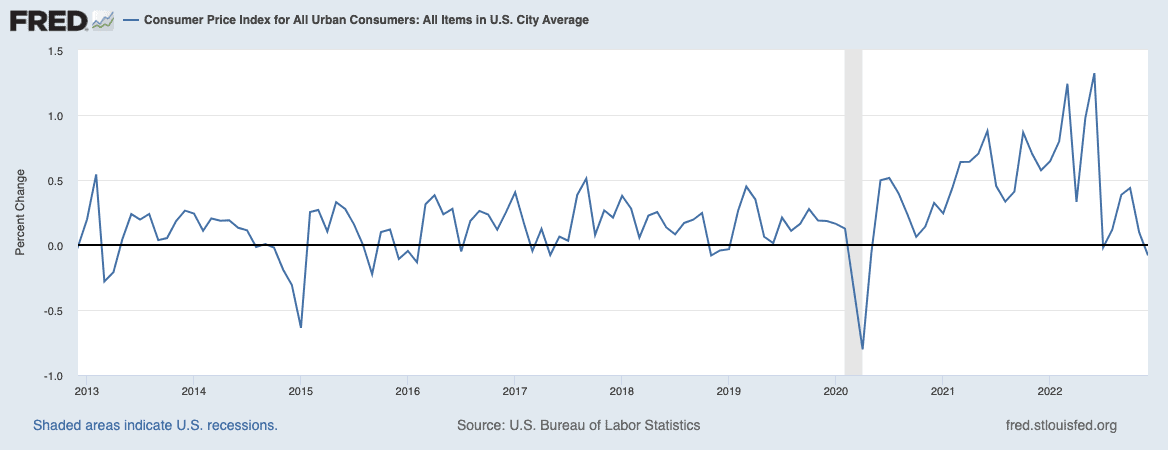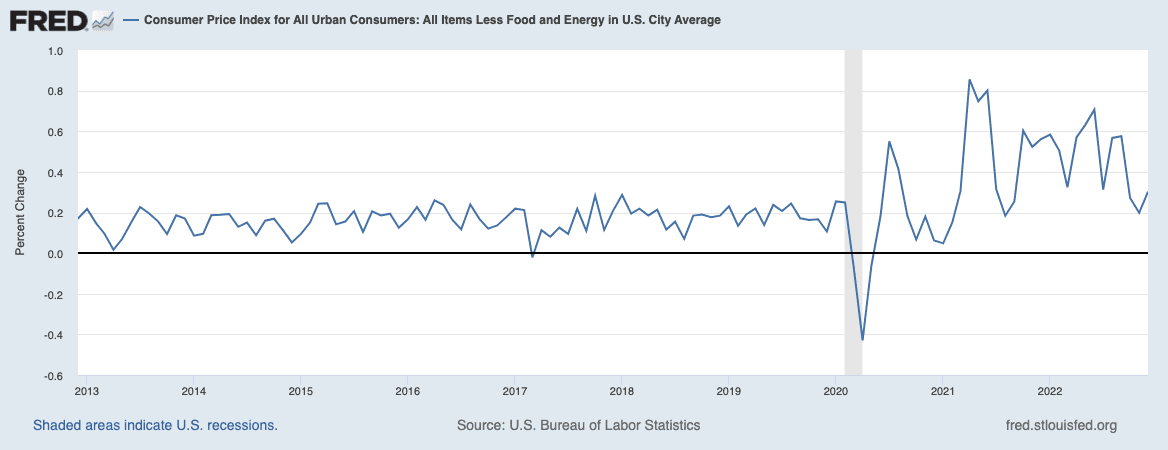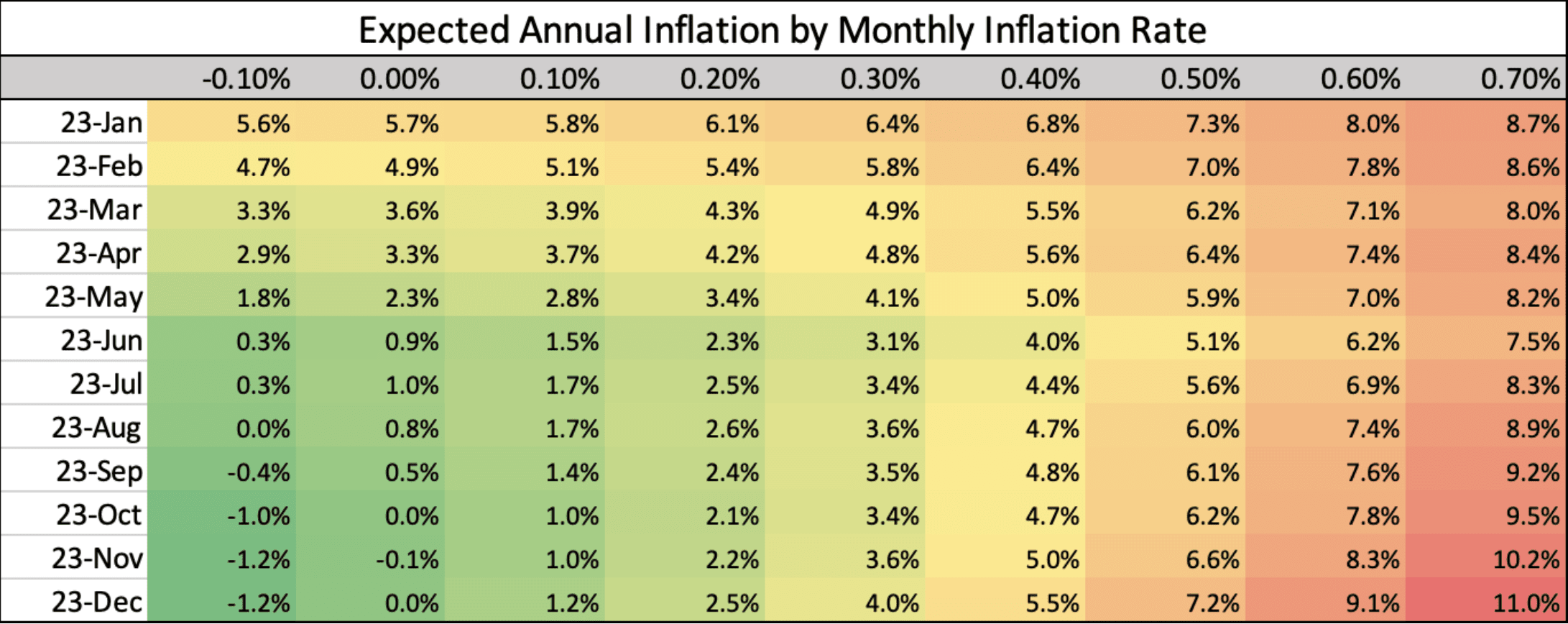On January 12, new Consumer Price Index (CPI) data was released for December, showing falling inflation rates across the board. The headline CPI, the broadest measure of inflation in the U.S., dropped to 6.5% year-over-year (YoY), down from 7.1% a month earlier. The “core” CPI, which excludes volatile food and energy prices, also fell to 5.7%, down from 6% in November.
While it’s encouraging to see the inflation rate drop on a YoY basis, the more relevant numbers from the CPI report come from the monthly data. Year-over-year data is inherently backward-looking, and I’m assuming everyone reading this is most interested in knowing what’s likely to happen over the course of 2023. The data there is a bit mixed.
Breaking Down The Numbers
When we look at the headline CPI, this month’s report is very encouraging, showing that prices actually fell 0.1% from November to December. Meaning for the broadest measure of inflation in the U.S., prices actually went down. This is a great sign for the CPI going into 2023. For inflation to get under control, the pace of price gains only needs to slow, but prices going backward like last month is even better.

The Core CPI tells a different story, with prices rising 0.3% in December, up from 0.2% in November. This is obviously not great, as the pace of inflation went up monthly, and the Federal Reserve is very focused on the Core CPI. 0.3% monthly inflation is still way too high.

Still, when looking at the last few years, there is a clear sign that things are heading in the right direction. Throughout 2021 and 2022, Core CPI growth was regularly above 0.4%, so seeing it come down to about 0.25% over the last three months is encouraging. But there’s still work to do. Personally, I’m optimistic things will keep trending in the right direction—mostly due to one part of the CPI that I am intimately familiar with—housing prices.
One of the major things keeping the Core CPI high is “shelter” inflation, which measures the cost of housing (both for renters and homeowners) in the U.S. As measured by the CPI, shelter costs rose around 0.7% last month alone!
What’s the deal with that? Anyone who looks at data knows that the cost of housing in the U.S. is falling, not rising! Rents and home prices are declining modestly right now, yet the CPI still shows them going up!
The reason is because the CPI measures of shelter lag by 6-12 months (it’s terrible, I know). So, the December 2022 report shows housing and rental data for the Summer of 2022! That’s annoying, but since the housing and rental markets started to shift in June/July, it means that the CPI will start reflecting the reality of housing prices in the coming months. To me, this is a strong indication that the Core CPI will fall over the course of the next six months. I can’t see how much and when, but I think it will trend downward in the first half of this year.
What Happens Next?
I wrote an article in November stating that I thought inflation had officially peaked and shared an analysis of monthly CPI rates and the reason for my belief. Here’s an update to that analysis.

The chart above projects year-over-year inflation numbers based on what happens to monthly increases going forward. For example, if inflation continues to decline by 0.1% each month (like it did this month), then we’ll be below the Fed’s 2% annualized target for inflation by May 2023.
I don’t think this is realistic, and we’re going to see modest monthly gains going forward. If we see an average monthly increase of 0.1%, we’ll be under the Fed’s target rate by June. If monthly inflation rises 0.16% (which is the average for the last six months), we can expect to be below the Fed’s target sometime over the summer. To me, this is a very realistic scenario.
Of course, the inflation rate could pick up steam again, but that seems very unlikely. In almost every dataset, we see that inflation has peaked and is starting to return to earth. There is still a ways to go, but it seems like we should have inflation under control sometime this year. That is fantastic news. Lower inflation is good for the economy and for every American who has been hurt by higher prices over the last few years.
What Will The Fed Do?
Despite this encouraging news, I expect the Fed will raise the federal funds rate at least one more time. But, I think we’re approaching the terminal rate (the rate at which the Fed stops raising rates), and we could see the end of this tightening cycle soon.
Pausing rate hikes does not mean falling rates, though. The Fed recently issued guidance saying they don’t intend to lower rates in 2023. Many investors think that’s a bluff, but personally, I take the Fed at its word and then hope I’m wrong. The Fed is dead serious about controlling inflation, and although I believe they’ll stop raising rates soon, they won’t lower rates at least in the next six months to be extra sure the risk of resurgent inflation is low.
Paused rates are still a good thing, though! So much of the economic turmoil we’re experiencing right now is due to uncertainty about Fed policy. If they stop raising rates in the next few months, it should give the entire economy some sense of stability and hopefully lead to a clearer and more optimistic economic outlook.
What do you think will happen in 2023 based on this inflation data? How will it impact your investing decisions? Let me know in the comments below.
On The Market is presented by Fundrise

Fundrise is revolutionizing how you invest in real estate.
With direct-access to high-quality real estate investments, Fundrise allows you to build, manage, and grow a portfolio at the touch of a button. Combining innovation with expertise, Fundrise maximizes your long-term return potential and has quickly become America’s largest direct-to-investor real estate investing platform.
Note By BiggerPockets: These are opinions written by the author and do not necessarily represent the opinions of BiggerPockets.
